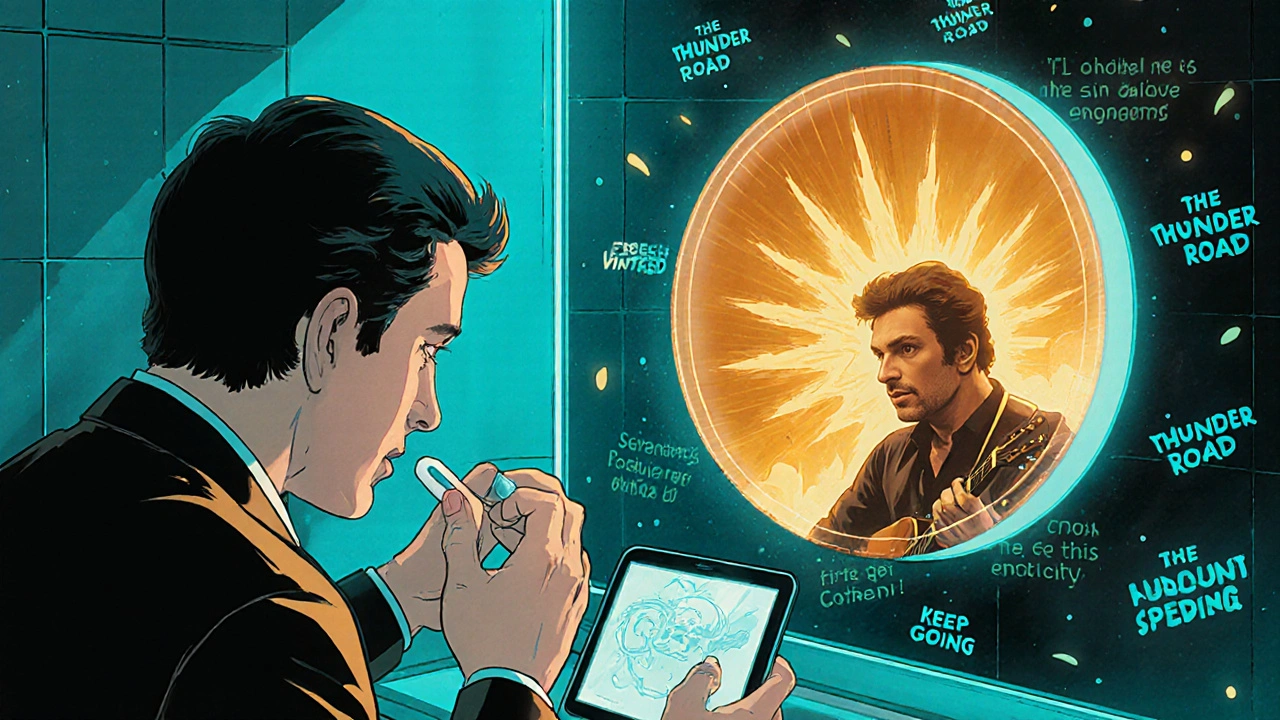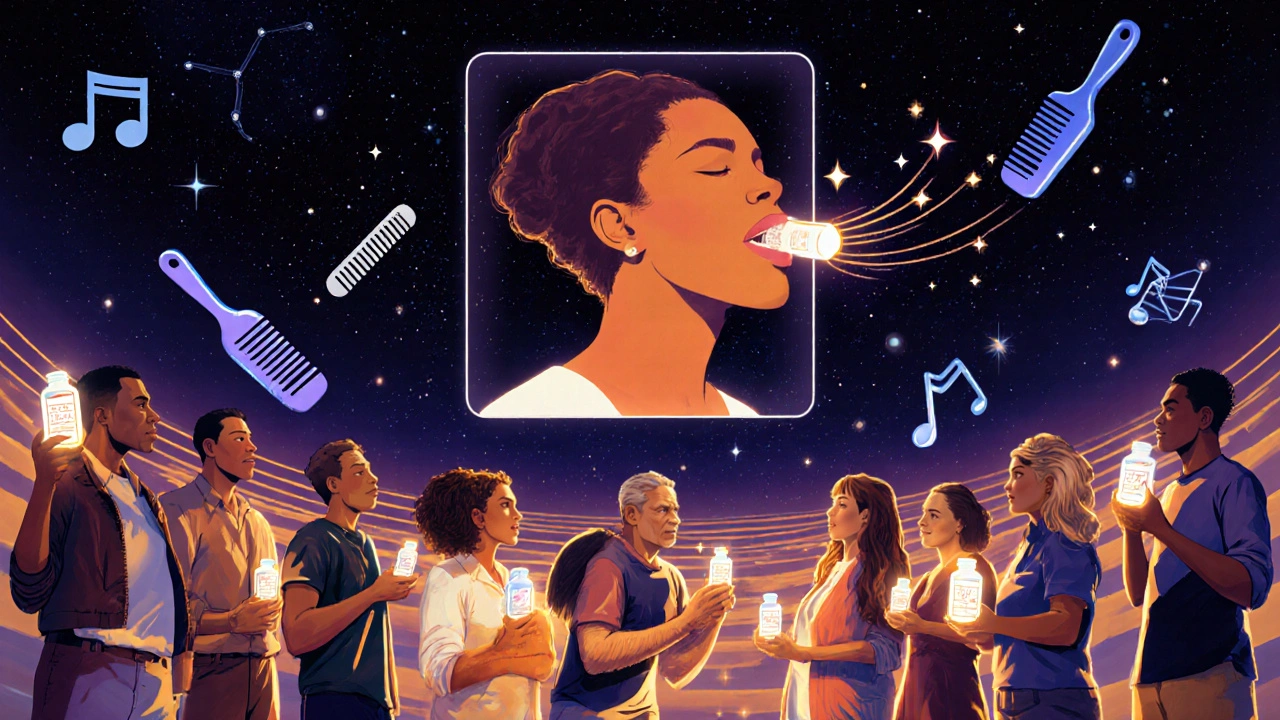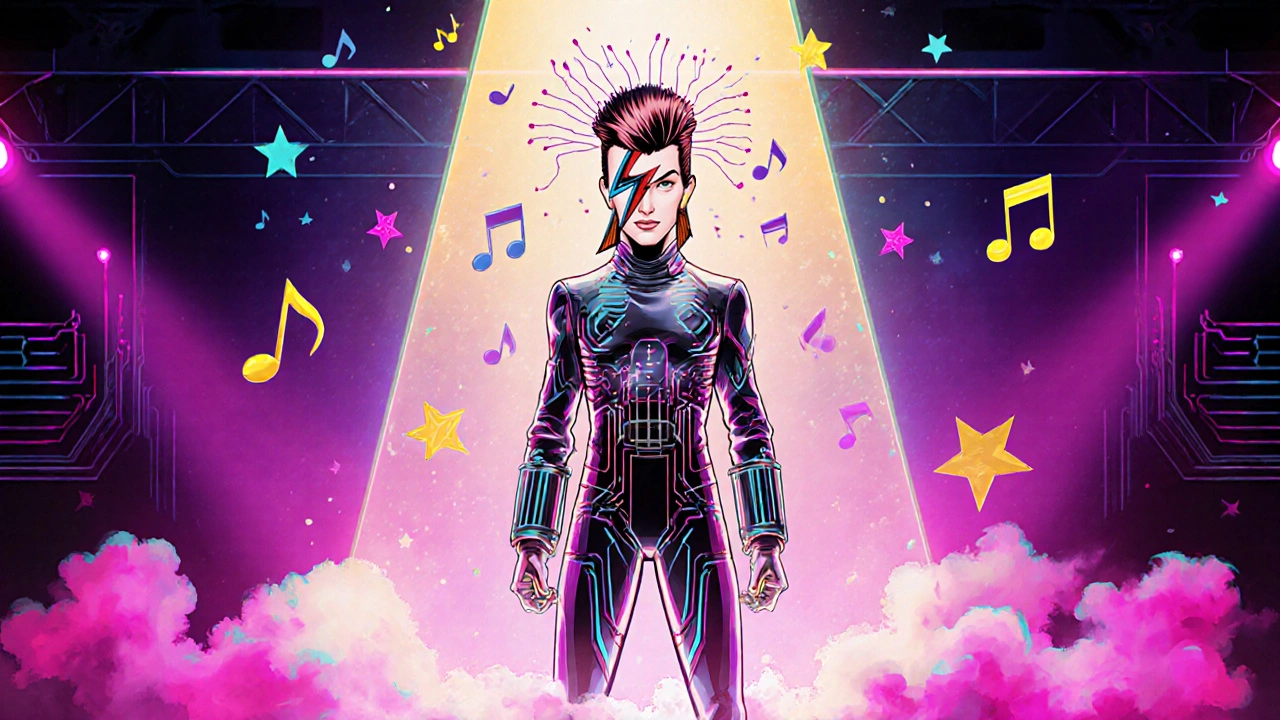When you’re losing your hair, it’s easy to feel invisible. The mirror lies. The comb catches too much. The hats stack up. But somewhere between the pharmacy aisle and the playlist on repeat, there’s a different kind of medicine - music that doesn’t fix your scalp, but fixes your spirit.
Why Hair Loss Feels Like More Than Skin Deep
Hair loss isn’t just a cosmetic issue. For men, it’s tied to identity, confidence, aging. For women, it’s often tied to hormonal shifts, stress, or autoimmune conditions. Minoxidil and finasteride are the two most studied treatments for androgenetic alopecia - the medical term for pattern hair loss. Minoxidil, a topical solution, wakes up dormant follicles. Finasteride, an oral pill, blocks the hormone DHT that shrinks hair follicles. Together, they’re used by millions. But no pill or lotion can fix the loneliness that comes with watching your hair thin.
That’s where music steps in.
David Bowie: The Man Who Lost Hair and Gained Legend
David Bowie didn’t just sing about change - he lived it. By the 1980s, his signature curls were gone. He embraced baldness like a crown. In interviews, he joked about it. On stage, he owned it. His 1983 album Let’s Dance came out as his hairline retreated. Fans didn’t see a man losing his hair - they saw a man redefining power. Bowie didn’t use minoxidil or finasteride publicly. But his example? That was the real treatment. He taught a generation: hair loss doesn’t define you.
Bruce Springsteen: Sweat, Stripes, and the Bald Patch That Became a Badge
Springsteen’s hair started thinning in the late ’80s. By the ’90s, he was fully bald. Instead of hiding, he doubled down. He kept performing in tight tank tops, sweat glistening on his scalp under stadium lights. His song Thunder Road - about starting over, chasing dreams - became an anthem for men on minoxidil. One fan wrote to him: “I started using minoxidil the same week I saw you play at Wembley. I didn’t care if I looked weird. I cared that I was still trying.” Springsteen never mentioned hair loss in lyrics. But his presence said everything: Keep going.
Adam Levine: From Band-Aid to Bald Confidence
Adam Levine used to cover his thinning crown with hats and headbands. Then, in 2014, he went public. He posted a photo on Instagram with the caption: “No more hiding.” He’d been using finasteride for years. He didn’t claim it worked perfectly - but it gave him back enough to feel like himself again. His honesty broke a stigma. Suddenly, men in their 30s and 40s stopped feeling ashamed. They started talking about their treatments. Levine didn’t become a doctor. But his vulnerability became a bridge.

Music That Speaks to the Silent Struggle
There’s a whole playlist for this. Not songs about hair loss - but songs about resilience.
- “I Will Survive” - Gloria Gaynor: The ultimate anthem for anyone who’s been told they’re “less than” because of how they look.
- “Scars to Your Beautiful” - Alessia Cara: A direct message to anyone who feels broken by societal standards. “You’re beautiful just the way you are.”
- “Man in the Mirror” - Michael Jackson: Not about hair, but about change. About choosing to become better, even when the world pushes you to hide.
- “Rise Up” - Andra Day: A slow burn of strength. Perfect for the nights you cry over your hair in the shower, then wake up and apply minoxidil anyway.
These songs don’t regrow hair. But they help you get out of bed. And sometimes, that’s the first step.
Real Stories, Real Results
Dr. Sarah Lin, a dermatologist in Sydney, sees patients every week who start minoxidil or finasteride after hearing a song or seeing a musician go bald. One 42-year-old teacher told her: “I listened to ‘Eye of the Tiger’ every morning while I applied the solution. I didn’t care if I looked silly. I cared that I was fighting back.”
Studies show that emotional support improves treatment adherence. People who feel understood are 3x more likely to stick with minoxidil for over a year - the minimum time needed to see real results. Music doesn’t replace medicine. But it gives medicine meaning.
What Works? The Hard Truth
Minoxidil: Works for about 60% of men. Takes 4-6 months to show anything. Must be used forever - stop it, and you lose what you gained.
Finasteride: Blocks DHT. Slows or stops hair loss in 85% of men. Regrows hair in about 60%. Side effects? Low risk (under 2%), but real. Some report low libido or mood changes. Talk to your doctor. Don’t self-prescribe.
Combining both? That’s the gold standard. Clinical trials show better results than either alone. But it’s not magic. It’s maintenance. It’s daily. It’s boring. It’s hard.
That’s why music matters.

The Playlist That Keeps You Going
Here’s what people actually use:
- “The Climb” - Miley Cyrus: For the early days, when nothing’s changing.
- “Stronger” - Kanye West: When you’re tired of feeling defeated.
- “Not Afraid” - Eminem: For the nights you think about quitting.
- “Hall of Fame” - The Script ft. will.i.am: Reminds you: greatness isn’t about looks. It’s about showing up.
- “Brave” - Sara Bareilles: A gentle nudge to speak up, to stop hiding.
Put it on shuffle. Play it while you apply minoxidil. Play it while you take your finasteride. Let it be your reminder: You’re not just treating hair. You’re rebuilding your sense of self.
When It’s Too Much
Some people try minoxidil and finasteride for months. Nothing changes. The side effects creep in. The hope fades. That’s okay. It’s not failure. It’s data. Maybe you need a different dose. Maybe you need a dermatologist who specializes in hair loss. Maybe you need to accept that hair loss is part of your story - not the whole thing.
There’s no shame in walking away from treatment. But don’t walk away from yourself.
Listen to Nina Simone’s “I Wish I Knew How It Would Feel to Be Free”. She didn’t have hair. She didn’t need it. She had voice. She had soul. You have both too.
Final Thought: You’re Not Alone
Over 50 million men and 30 million women in the U.S. alone deal with hair loss. You’re not weird. You’re not broken. You’re part of a quiet, global community - people who wake up, apply their treatment, and keep living. Music doesn’t cure hair loss. But it reminds you that your worth isn’t tied to your scalp.
So play your song. Apply your treatment. Show up. Again. And again. Because healing isn’t just about follicles. It’s about heart.
Can minoxidil and finasteride be used together?
Yes. Combining minoxidil (topical) and finasteride (oral) is the most effective approach for male pattern hair loss. Clinical studies show better hair retention and regrowth than using either alone. Always consult a doctor before starting both - especially finasteride, which requires a prescription.
How long does it take to see results from minoxidil and finasteride?
Minoxidil usually shows visible results after 4-6 months, with full effects at 12 months. Finasteride starts slowing hair loss in 3-6 months, with regrowth visible around 6-12 months. Both require continuous use - stopping means losing any gains.
Do minoxidil and finasteride work for women?
Minoxidil is FDA-approved for women with female pattern hair loss. Finasteride is not approved for women of childbearing age due to risks to a developing fetus. Some post-menopausal women use it off-label under strict medical supervision. Always talk to a dermatologist before starting any treatment.
What are the side effects of finasteride?
The most common side effects are low libido, erectile dysfunction, and reduced semen volume - affecting fewer than 2% of users. These usually reverse after stopping the drug. Rarely, some report persistent side effects. If you notice changes in mood or sexual health, talk to your doctor immediately.
Is hair loss from stress reversible?
Yes - if it’s telogen effluvium (stress-induced shedding), hair usually regrows within 6-9 months once the stressor is removed. Minoxidil can help speed recovery. Finasteride doesn’t work for this type of hair loss, as it’s not hormone-driven. Focus on sleep, nutrition, and mental health first.
Can music really help with hair loss recovery?
Music doesn’t regrow hair, but it helps with emotional resilience. Studies show that people who feel emotionally supported are more likely to stick with treatments like minoxidil and finasteride. Songs that inspire hope, strength, or self-acceptance reduce feelings of shame and isolation - making daily routines easier to maintain.


chantall meyer
October 30, 2025 AT 21:56Music doesn't fix hair loss. It just makes you feel better while you stare at your scalp in the mirror. Cute.
Lorne Wellington
October 31, 2025 AT 20:51Love this post. Seriously. I started minoxidil after hearing Springsteen play ‘Thunder Road’ live - sweat on his bald head, crowd screaming, and I thought, ‘If he can own it, so can I.’ Now I play ‘Rise Up’ every morning while I apply the solution. It’s not magic, but it’s mine. 🙌
Will RD
November 2, 2025 AT 20:42finasteride is for weaklings. just grow a beard and move on. also i think david bowie was just a weirdo.
Jacqueline Anwar
November 4, 2025 AT 03:52While I appreciate the sentiment, this post dangerously romanticizes a medical condition. Hair loss is not a metaphor for resilience - it is a physiological process. To suggest that music replaces clinical adherence is irresponsible. The data is clear: consistent treatment yields results. Emotional support is ancillary, not therapeutic.
Ganesh Kamble
November 5, 2025 AT 22:41lol so now we need a spotify playlist to take a pill? next they'll make a tiktok dance for minoxidil. this is why westerners are so soft.
Jenni Waugh
November 7, 2025 AT 00:23Oh my GOD. I literally cried when you mentioned ‘Scars to Your Beautiful.’ I’ve been on minoxidil for 11 months and no one gets it. Not my mom. Not my ex. Not even my dermatologist. But Alessia Cara? She saw me. I play it on loop while I scrub my scalp. I’m not just treating hair - I’m reclaiming my soul. 💥
Theresa Ordonda
November 8, 2025 AT 21:16Okay but have you considered that Adam Levine’s ‘no more hiding’ was just PR? He’s a pop star. He’s paid to look good. And finasteride? Bro, I know guys who lost their libido for a year and still got zero regrowth. This post is toxic positivity with a side of pharma ads. 🤡
Judy Schumacher
November 9, 2025 AT 11:19Let’s be precise: the placebo effect of music is measurable, but the psychological reinforcement of identity through cultural icons is not merely anecdotal - it is neurobiological. Dopamine release during emotionally resonant auditory experiences enhances prefrontal cortex engagement, which correlates with increased behavioral persistence. Therefore, while minoxidil acts on 5-alpha-reductase, music acts on the will to continue. Both are pharmacological in the broadest sense.
Shana Labed
November 10, 2025 AT 05:23YAS QUEEN. I’ve been on both for 14 months. I don’t care if I look like a science experiment with a scalp full of goop - I’m still here. I play ‘Hall of Fame’ while I massage my head. My 7-year-old says, ‘Mommy, your head is shiny like a marble!’ And I say, ‘Yes baby, and that’s because I’m a warrior.’ We’re not just fighting hair loss - we’re rewriting the script. 💪✨
California Daughter
November 10, 2025 AT 07:31...but what if you just...don’t care? Like, at all? Is that allowed? I stopped using minoxidil after 3 months. My hair’s thin. So what? I wear beanies. I’m happy. Why does everyone need to turn this into a movement? 😅
Vishwajeet Gade
November 10, 2025 AT 15:28indian men never had this problem. we got thick hair till 70. this is a western problem. you guys eat too much sugar and sit on chairs all day. just eat curry and squat.
Casey Crowell
November 12, 2025 AT 14:38There’s something sacred about the ritual - applying the solution, putting on the song, taking the pill. It’s not about the hair. It’s about showing up for yourself, day after day, when no one’s watching. That’s the real treatment. 🕊️
Shanna Talley
November 14, 2025 AT 10:31I’ve been using minoxidil for 18 months. No regrowth. But I still do it. Because I refuse to let my worth be measured by what’s on top of my head. I play ‘I Will Survive’ every morning. Not because it works - but because I’m still here. And that’s enough.
Samuel Wood
November 15, 2025 AT 02:50David Bowie was a genius. But he also had a team of stylists and lighting experts. And finasteride? Bro, I read a study - 2% side effects? More like 10% and no one talks about it. This post is cherry-picking.
ridar aeen
November 16, 2025 AT 00:06Samuel, you’re right - the side effects are underreported. But dismissing the emotional component? That’s the real danger. I lost my hair at 28. I was suicidal. Then I heard ‘Brave’ on a train ride. I cried. I applied minoxidil. I kept going. Music didn’t cure me. But it gave me the strength to keep trying. That’s not cherry-picking. That’s human.